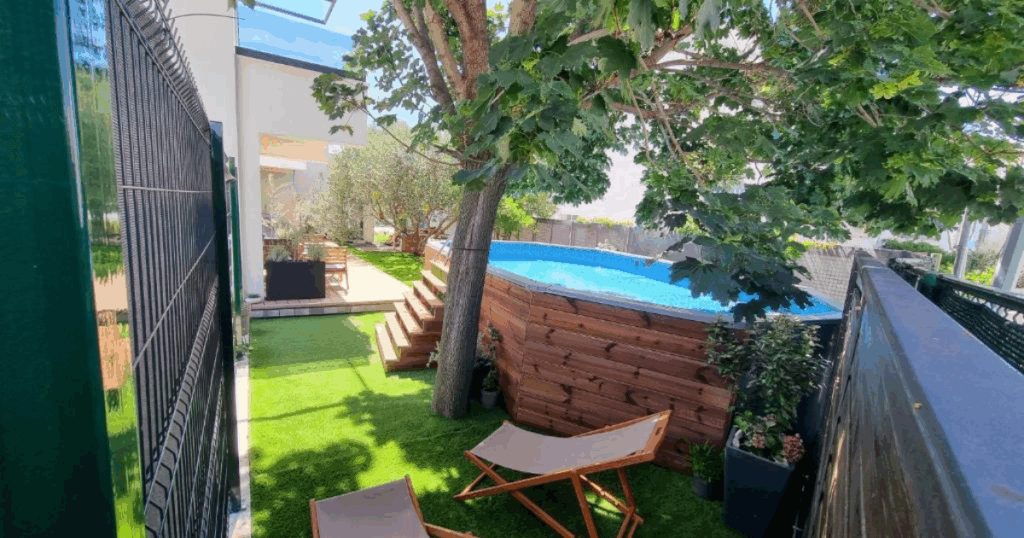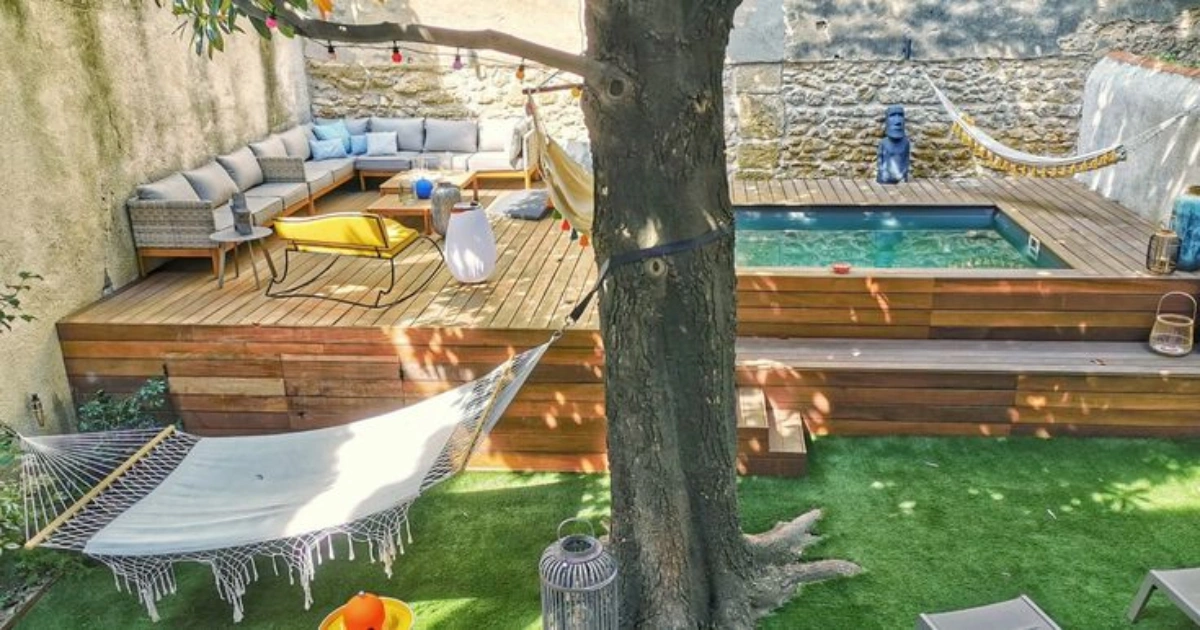Introduction
Transforming an underutilized outdoor area into a vibrant, functional space can significantly enhance the aesthetic appeal and usability of a home. This case study delves into the process of revitalizing a neglected backyard into a welcoming outdoor living area, highlighting key design elements and considerations that contributed to its successful transformation.
🏡 Before: The Original Space
The initial state of the backyard presented several challenges:
- Sparse Vegetation: The area featured minimal plant life, lacking the lush greenery that contributes to a serene environment.
- Limited Furnishings: A solitary bench provided little comfort or functionality, failing to encourage extended use of the space.
- Uninviting Atmosphere: The overall ambiance was uninspiring, with no clear purpose beyond basic utility.
These factors rendered the space underutilized, prompting the need for a comprehensive redesign.
🌟 After: The Transformed Outdoor Oasis
The redesigned backyard now serves as a multifunctional outdoor retreat, incorporating various elements to enhance its appeal and usability:
1. Lounge Area
A comfortable seating arrangement with plush cushions creates an inviting space for relaxation and social gatherings. This area serves as the focal point for outdoor entertainment.
2. Decking and Pool
The addition of a wooden deck and a swimming pool introduces both functionality and luxury, offering a space for leisure and recreation.
3. Landscaping
The use of artificial grass and strategically placed plants contributes to a low-maintenance yet aesthetically pleasing environment, enhancing the overall ambiance.
4. Decorative Touches
Incorporating elements like a hammock and vibrant accessories adds personality and warmth to the space, making it feel more like an extension of the home.

🧰 Key Design Elements and Materials
- Seating: Weather-resistant outdoor furniture with comfortable cushions.
- Decking: Pressure-treated wood or composite materials for durability.
- Pool: Above-ground or in-ground options, depending on space and budget.
- Landscaping: Artificial turf, drought-tolerant plants, and decorative planters.
- Lighting: Solar-powered or LED lights to create ambiance during evening hours.
- Accessories: Outdoor rugs, throw pillows, and decorative lanterns.
✅ Benefits of the Transformation
- Enhanced Aesthetic Appeal: The redesign introduces cohesive design elements that elevate the visual appeal of the space.
- Increased Usability: The addition of functional areas encourages more frequent use of the outdoor space.
- Improved Property Value: A well-designed outdoor area can increase the overall value of the property.
- Personalized Environment: The incorporation of personal touches makes the space uniquely suited to the homeowner’s preferences.
🌱 Seasonal Considerations
- Spring/Summer: Focus on planting seasonal flowers and maintaining the pool area.
- Fall: Prepare the space for cooler weather by adding outdoor heaters and cozy textiles.
- Winter: Protect outdoor furniture and plants from harsh conditions; consider adding festive lighting for ambiance.
🔧 Tools and Materials Checklist
- Outdoor furniture sets
- Decking materials (wood or composite)
- Pool installation kit or services
- Artificial grass rolls
- Landscaping plants and planters
- Outdoor lighting fixtures
- Decorative accessories (pillows, rugs, lanterns)
❓ Frequently Asked Questions (FAQs)
Q1: How do I maintain artificial grass?
A1: Regularly remove debris, brush the fibers to keep them upright, and rinse with water to remove dust and pet odors.
Q2: What are the benefits of using composite decking over wood?
A2: Composite decking is low-maintenance, resistant to rot and insects, and offers a longer lifespan compared to traditional wood.
Q3: Can I install a pool in a small backyard?
A3: Yes, options like above-ground pools or plunge pools are suitable for smaller spaces and can be customized to fit your yard’s dimensions.
Q4: How can I create privacy in my outdoor space?
A4: Utilize privacy screens, tall plants, or trellises with climbing vines to create secluded areas within your backyard.
🏁 Conclusion
This case study demonstrates how thoughtful design and strategic planning can transform an underutilized outdoor area into a functional and aesthetically pleasing space. By incorporating elements that reflect personal style and cater to specific needs, homeowners can create an outdoor retreat that enhances their living experience.


order amoxil pill – cheap amoxil online cheap amoxil pill
brand diflucan – fluconazole 100mg oral buy forcan sale
buy escitalopram 20mg online – lexapro online escitalopram tablet
cenforce 100mg brand – cenforce for sale buy cenforce 100mg
cialis over the counter usa – https://ciltadgn.com/ cialis canada free sample
cialis genetic – click tadalafil cialis
buy cheap viagra in the uk – buy cheap viagra in the uk buy viagra in dubai
The thoroughness in this break down is noteworthy. prednisone and fibromyalgia
This is a theme which is in to my fundamentals… Many thanks! Unerringly where can I find the phone details in the course of questions? synthroid en espaГ±ol
This is the big-hearted of writing I truly appreciate. https://prohnrg.com/product/lisinopril-5-mg/
Thanks on putting this up. It’s well done. https://ursxdol.com/synthroid-available-online/
This website exceedingly has all of the tidings and facts I needed there this subject and didn’t positive who to ask. acheter xenical 120 mg pas cher
Palatable blog you be undergoing here.. It’s severely to espy strong quality writing like yours these days. I really respect individuals like you! Go through guardianship!! https://ondactone.com/product/domperidone/
This is the compassionate of literature I positively appreciate.
https://doxycyclinege.com/pro/celecoxib/
More posts like this would prosper the blogosphere more useful. http://bbs.51pinzhi.cn/home.php?mod=space&uid=7053857
buy forxiga 10mg online cheap – https://janozin.com/ forxiga medication
orlistat where to buy – xenical price purchase xenical pills
I am in truth thrilled to glance at this blog posts which consists of tons of worthwhile facts, thanks towards providing such data. http://mi.minfish.com/home.php?mod=space&uid=1421100
You can shelter yourself and your dearest by being heedful when buying medicine online. Some druggist’s websites control legally and provide convenience, privacy, bring in savings and safeguards over the extent of purchasing medicines. buy in TerbinaPharmacy https://terbinafines.com/product/imitrex.html imitrex
You can protect yourself and your family by being cautious when buying panacea online. Some pharmaceutics websites control legally and offer convenience, secretiveness, cost savings and safeguards as a replacement for purchasing medicines. buy in TerbinaPharmacy https://terbinafines.com/product/zantac.html zantac
This is a theme which is forthcoming to my heart… Many thanks! Unerringly where can I notice the phone details in the course of questions? Г©quivalent viagra homme
You can protect yourself and your stock close being heedful when buying prescription online. Some pharmaceutics websites manipulate legally and offer convenience, privacy, cost savings and safeguards over the extent of purchasing medicines. http://playbigbassrm.com/
More delight pieces like this would urge the интернет better.
https://t.me/officials_pokerdom/3998
https://t.me/s/dragon_money_mani